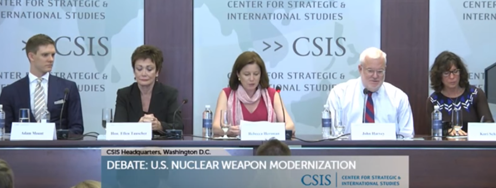How the Debt Deal Creates an Opportunity to Cut Nuclear Weapons
As the dust settles on the debt ceiling deal, it’s become clear that major cuts to defense spending have not only been approved in a bipartisan manner by Congress, but that even more are on the way. This means that the days of unlimited defense spending increases, where all systems can be purchased, are over.
So now is the time for tough choices to be made between defense programs that serve our warriors and those that we have maintained for too long due to bureaucratic, parochial or ideological reasons. It’s time to stop spending dollars that we don't have on programs that we don't need and that don’t make us more secure.
And there is a clear target for such cutting: nuclear weapons. Making these cuts will fit neatly into the broader framework on defense cutting that this debt deal has created.
It’s worth noting that even though the debt deal has detractors who are concerned that it doesn’t specify the exact defense cuts to be made, this deal is already having an impact on the political debate, as profligate defense spenders are up in arms. There are real spending caps in the deal that, because of perpetual inflation, will reduce the Pentagon’s purchasing power and force cutbacks.
Therefore, the strategic success that this agreement has created by reining in defense spending through the budgetary spending caps, while not conventional wisdom yet in Washington, has set the stage for a battle on the types of specific cuts – yet to be defined - that are envisioned in this plan.
It’s worth noting that what this debt deal essentially does is provide Congressional approval for the President’s call for major defense cuts, which was initially announced at a level of $400 billion over 12 years. Not only that, but Congress has now approved steeper annual cuts, which according to the White House will be $350 billion to the base defense budget over 10 years, which is equivalent to $420 billion over a dozen years.
The argument about whether to cut defense is now over. Bipartisan support for its cutting is real.
So with Congress now endorsing the President’s position, and poised to make additional cuts in the second phase of the debt ceiling process – potentially $500 billion worth – it’s a new fact of life in Washington that defense will be cut.
Yet while the topline limits for a new category – security spending, which includes defense – have been set, Congress still has the responsibility to fill in the blanks on which programs will live and which will die.
This is because Congress has, in essence, approved its first Budget Resolution in more than two years. That’s right. What this debt ceiling deal has done is install budget caps on discretionary spending in a manner that Washington hasn’t seen since Democrats controlled both Chambers of Congress.
This is where the opportunity to cut nuclear weapons spending lies.
In essence, the new budget caps, which fit within a “security” spending category that defines security as defense, homeland security, international affairs, veterans affairs, and nuclear weapons, are the forcing mechanism for nuclear pork cuts. This is because in fiscal year 2012, the new budget ceiling for security is $684 billion; the President’s request however totaled over $720 billion for these accounts – meaning that nearly $36 billion in cuts from the President’s request need to be found.
Yet because the security category is broader than the traditional Budget Resolution accounts, which are typically broken down into appropriations account categories, questions have arisen about how the cuts will be made.
The answer therefore is to cut wasteful defense programs that do not advance our national security.
Fortunately, the new budget ceiling will help do just that, by putting downward pressure on appropriators to make real decisions within the security accounts, forcing them to make tough tradeoffs and choices – the kinds of tradeoffs typically avoided during appropriations processes that lack budget caps.
Hard choices about our defense spending will have to be made. And there are some clear targets for cutting, particularly in the nuclear weapons accounts.
This means that nuclear weapons should be on the chopping block.
As Congress begins to define the contours of the debt ceiling deal that it just approved, it’s clear that the debate now isn’t whether or not to cut defense spending, but is instead about which defense programs should disappear.
There is still much to be defined, yet the inherently competitive situation now shaping up on defense spending is welcome news to those who have been long seeking to get rid of the bloated weapons systems that weaken our economy while doing scant little to advance our national security.




